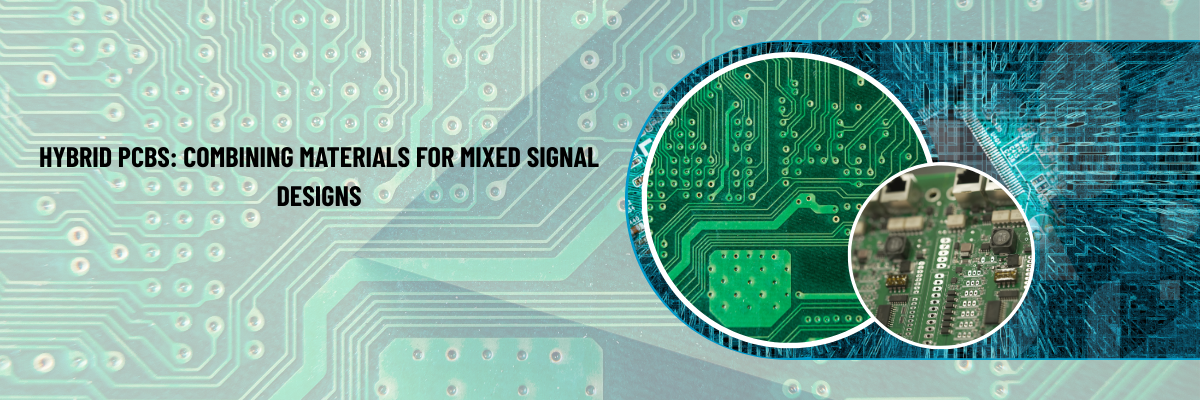Hybrid PCBs are advanced printed circuit boards that combine different materials. This innovative approach allows engineers to optimize each layer’s properties, balancing performance and cost-efficiency. In mixed-signal applications, where both analog and digital circuits interact, hybrid PCBs minimize noise and enhance signal integrity. This post delves into how hybrid PCBs address the unique challenges of mixed-signal designs, offering practical insights into material selection, design considerations, and real-world applications. Whether you’re designing for automotive, telecommunications, medical devices, or any other segment, this post discusses mixed-signal designs, their advantages, applications, and more.
Understanding Mixed-Signal Designs
Mixed-signal designs refer to systems that incorporate both analog and digital circuits on a single PCB. These designs are common in devices such as communication systems, sensors, and audio equipment, where precise analog signals need to interact with digital processing elements.
One of the main challenges in mixed-signal systems is ensuring signal integrity. Analog signals are often susceptible to noise from digital circuits, which can lead to errors and degraded performance. Effective mixed-signal PCB design requires careful management of power, ground planes, and signal routing to minimize interference and optimize performance. Hybrid PCBs, by utilizing the right combination of materials, offer solutions to these challenges, making them ideal for mixed-signal applications.
Role of Materials Used in Hybrid PCBs
Hybrid PCBs combine multiple materials, each chosen for its unique electrical and thermal properties, to meet the specific requirements of both analog and digital circuits. Common materials used include FR4, PTFE (Teflon), ceramics, and metal core substrates.
- FR4 is cost-effective and widely used for general-purpose boards, providing good mechanical strength and electrical insulation.
- PTFE offers low dielectric loss and is ideal for high-frequency signals, making it suitable for analog circuits in mixed-signal designs.
- Ceramic materials provide excellent thermal management and are highly stable, which is essential for sensitive analog circuits.
- Metal core PCBs are used when heat dissipation is crucial, often in power-intensive applications.
Advantages of Hybrid PCBs in Mixed-Signal Designs
Hybrid PCBs offer several key advantages in mixed-signal designs, where both analog and digital circuits must coexist on the same board. Here are some of the key benefits.
- Enhanced signal integrity: By using different materials for specific layers, hybrid PCBs minimize noise interference between analog and digital circuits. Materials such as PTFE and ceramics are especially effective at isolating sensitive analog signals from the noisy digital side, ensuring clearer and more accurate signal transmission.
- Improved performance: Hybrid PCBs can be customized to meet the unique needs of mixed-signal systems. With optimized material properties, these boards ensure that both analog and digital circuits perform at their best, even under demanding conditions.
- Reduced crosstalk: Hybrid PCBs help in reducing crosstalk between analog and digital components. By strategically placing grounding and shielding layers, engineers can prevent signal overlap.
- Cost effectiveness: Despite the use of multiple materials, hybrid PCBs can be a cost-effective solution. By selecting the right material combination for specific requirements, manufacturers can reduce overall board costs while improving performance.
- Thermal management: Hybrid PCBs provide superior thermal management. This helps prevent overheating in power-intensive circuits, ensuring long-term reliability and durability of mixed-signal devices.
Applications of Hybrid PCBs in Mixed-Signal Systems
Hybrid PCBs are essential in a variety of industries where mixed-signal systems are critical for performance and reliability. Some of the most notable applications include.
- Automotive: In modern vehicles, mixed-signal systems are employed in safety systems, infotainment, and engine control units (ECUs). They allow for the effective integration of analog sensors with digital control systems, ensuring reliability in harsh environments.
- Medical devices: In medical electronics, precise analog signals from sensors must be processed by digital circuits. Hybrid PCBs provide the necessary isolation between these signals, improving accuracy and performance, which is crucial for patient safety.
- Consumer electronics: Many consumer devices, such as smart speakers and wearables, utilize mixed-signal designs. Hybrid PCBs enable these devices to process analog signals while performing complex digital computations, all within a compact and cost-efficient design.
- Industrial control systems: Hybrid PCBs are widely used in industrial automation systems, robotics, and sensor networks, where both analog control signals and digital processing are required. These boards help in providing efficient, interference-free communication and reliable operation in tough industrial environments.
Hybrid PCBs are a powerful solution for mixed-signal designs, offering numerous benefits like enhanced signal integrity, improved performance, and cost effectiveness. As technology continues to evolve, the role of hybrid PCBs in ensuring reliable and efficient mixed-signal systems will only grow.
If you are looking to integrate hybrid PCB solutions in your next project, Rigiflex Technology, Inc. provides the expertise and cutting-edge technology needed to deliver high-performance, reliable, and cost-effective PCBs tailored to your specific requirements.
Contact the team at Rigiflex today to discuss how we can help bring your mixed-signal designs to life with precision and efficiency.

